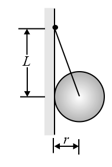As shown in the figure given below a thin wire or cable with negligible mass and a hinge support a horizontal beam of negligible mass and length . The angle between the wire and the beam is . A block of mass will be moved along the beam; let be the distance between the hinge and the block's center of mass. As a function of . find (a) the tension in the wire, and the (b) horizontal and (c) vertical components of the force on the beam from the hinge.
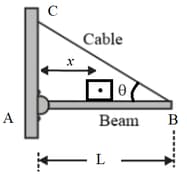


Important Questions on Equilibrium and Elasticity
In the figure shown below, a horizontal scaffold of length and uniform mass , is suspended from a building by two cables. The scaffold has dozens of paint cans stacked on it at various points. The total mass of the paint cans is . The tension in the cable at the right is . How far horizontally from that cable is the center of mass of the system of paint cans?

The figure represents an insect caught at the midpoint of a spider-web thread. The thread breaks under a stress of and a strain of . Initially, it was horizontal and had a length of , and a cross-sectional area of . As the thread was stretched under the weight of the insect, its volume remained constant. If the weight of the insect puts the thread on the verge of breaking, what is the insect's mass? (A spider's web is built to break if a potentially harmful insect, such as a bumble bee, becomes snared in the web.)

In the figure shown below, a climber with a weight of is held by a belay rope connected to her climbing harness and belay device; the force of the rope on her has a line of action through her center of mass. The indicated angles are and . If her feet are on the verge of sliding on the vertical wall, what is the coefficient of static friction between her climbing shoes and the wall?
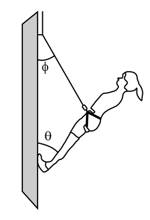
In the figure shown below, a lead brick rests horizontally on cylinders and . The areas of the top faces of the cylinders are related by , the Young's moduli of the cylinders are related by . The cylinders had identical lengths before the brick was placed on them. What fraction of the brick's mass is supported by cylinder and by cylinder ? The horizontal distances between the center of mass of the brick and the centerlines of the cylinders are for cylinder and for cylinder . What is the ratio ?
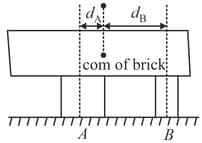
In the figure shown below, one end of a uniform beam of mass is hinged to a wall, the other end is supported by a wire that makes angles with both wall and beam. Find the tension in the wire and the magnitude and angle from the horizontal of the force of the hinge on the beam.
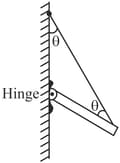
In the figure shown below, a cord with negligible mass suspends a uniform ball against a frictionless vertical wall. The ball's mass is , its radius is and the vertical distance between the ball's center and the cord attachment on the wall is the cord's tension and (b) the magnitude of the normal force on the wall from the ball? (Take )
